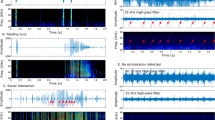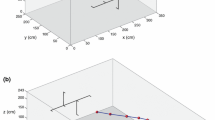Abstract
Bats alter their echolocation in response to changes in ecological and behavioral conditions, but little is known about how they adjust call structure in response to changes in altitude. We examined altitudinal variation in the echolocation of Brazilian free-tailed bats, Tadarida brasiliensis, a species known to fly to altitudes of 3,000 m above the ground. From 50.2 h of recordings, we analyzed 113 high-quality echolocation call sequences recorded from 0 to 862 m above ground level. Bats flying near the ground used shorter, higher-frequency, broader-bandwidth calls compared to bats at higher altitudes, an effect likely due to the greater levels of echo-producing clutter (i.e., vegetation, buildings) found near the ground. When ground-level recordings are excluded, bats continue to shift towards the use of longer-duration, lower-frequency, narrower-bandwidth calls with increasing altitude. We propose that the observed high-altitude changes in call structure are a response to changing acoustic attenuation rates and/or decreasing insect densities at higher altitudes.




Similar content being viewed by others
References
ANSI (1978) Method for the calculation of the absorption of sound by the atmosphere. ANSI S1.26-1978
Barclay RMR, Fenton MB, Thomas DW (1979) Social behavior of the little brown bat, Myotis lucifugus. 2. Vocal communication. Behav Ecol Sociobiol 6:137–146
Bayefsky-Anand S, Skowronski MD, Fenton MB, Korine C, Holderied MW (2008) Variations in the echolocation calls of the European free-tailed bat. J Zool 275:115–123
Beerwinkle KR, Lopez JD, Witz JA, Schleider PG, Eyster RS, Lingren PD (1994) Seasonal radar and meteorological observations association with nocturnal insect flight at altitudes to 900 meters. Environ Entomol 23:676–683
Beerwinkle KR, Lopez JD, Schleider PG, Lingren PD (1995) Annual patterns of aerial insect densities at altitudes from 500 to 2400 meters in east-central Texas indicated by continuously-operating vertically-oriented radar. Southwest Entomol Suppl 18:63–79
Berger-Tal O, Berger-Tal R, Korine C, Holderied MW, Fenton MB (2008) Echolocation calls produced by Kuhl's pipistrelles in different flight situations. J Zool 274:59–64
Betke M, Hirsch DE, Makris NC, McCracken GF, Procopio M, Hristov NI, Tang S, Bagchi A, Reichard JD, Horn JW, Crampton S, Cleveland CJ, Kunz TH (2008) Thermal imaging reveals significantly smaller Brazilian free-tailed bat colonies than previously estimated. J Mammal 89:18–24
Bonner WD, Paegle J (1970) Diurnal variation in boundary layer winds over the South-Central United States in summer. Mon Weather Rev 98:735–744
Crocker MJ (1998) Handbook of acoustics. Wiley-Interscience, New York
Davis RB, Herreid CE, Short HL (1962) Mexican free-tailed bats in Texas. Ecol Monogr 32:311–346
Fenton MB, Griffin DR (1997) High-altitude pursuit of insects by echolocating bats. J Mammal 78:247–250
Gillam EH (2007) Eavesdropping by bats on the feeding buzzes of conspecifics. Can J Zool 85:795–801
Gillam EH, McCracken GF (2007) Variability in the echolocation of Tadarida brasiliensis: effects of geography and local acoustic environment. Anim Behav 74:277–286
Gillam E, Ulanovsky N, McCracken GF (2007) Rapid jamming avoidance in biosonar. Proc R Soc Lond B Biol 274:651–660
Griffin DR (1958) Listening in the dark. Yale University Press, New Haven
Griffin DR (1971) Importance of atmospheric attenuation for echolocation of bats (Chiroptera). Anim Behav 19:55–61
Griffin DR, Thompson D (1982) High altitude echolocation of insects by bats. Behav Ecol Sociobiol 10:303–306
Habersetzer J (1981) Adaptive echolocation sounds in the bat Rhinopoma hardwickei—a field study. J Comp Physiol 144:559–566
Holderied MW, Jones G, von Helversen O (2006) Flight and echolocation behaviour of whiskered bats commuting along a hedgerow: range-dependent sonar signal design, Doppler tolerance and evidence for ‘acoustic focusing’. J Exp Biol 209:1816–1826
Jensen ME, Miller LA (1999) Echolocation signals of the bat Eptesicus serotinus recorded using a vertical microphone array: effect of flight altitude on searching signals. Behav Ecol Sociobiol 47:60–69
Johnson SJ (1995) Insect migration in North America: synoptic-scale transport in a highly seasonal environment. In: Drake VA, Gatehouse AG (eds) Insect migration: tracking resources through space and time. Cambridge University Press, New York
Jones G (1994) Scaling of wingbeat and echolocation pulse emission rates in bats: why are aerial insectivorous bats so small? Funct Ecol 8:450–457
Jones G, Holderied MW (2007) Bat echolocation calls: adaptation and convergent evolution. Proc R Soc Lond B Biol 274:905–912
Kalcounis MC, Hobson KA, Brigham RM, Hecker KR (1999) Bat activity in the boreal forest: importance of stand type and vertical strata. J Mammal 80:673–682
Kalko EKV, Schnitzler HU (1993) Plasticity in echolocation signals of European pipistrelle bats in search flight - implications for habitat use and prey detection. Behav Ecol Sociobiol 33:415–428
Lawrence BD, Simmons JA (1982) Measurements of atmospheric attenuations at ultrasonic frequencies and the significance for echolocation by bats. J Acoust Soc Am 71:585–590
Lee YF, McCracken GF (2005) Dietary variation of Brazilian free-tailed bats links to migratory populations of pest insects. J Mammal 86:67–76
McCracken GF, Gillam EH, Westbrook JK, Lee YF, Jensen ML, Balsley BB (2008) Brazilian free-tailed bats (Tadarida brasiliensis: Molossidae, Chiroptera) at high altitude: links to migratory insect populations. Integr Comp Biol 48:107–118
Menzel JM, Menzel MA, McCracken GF, Chapman BR (2000) Notes on bat activity above the forest canopy in the eastern United States. Ga J Sci 58:212–216
Norberg UM, Rayner JMV (1987) Ecological morphology and flight in bats (Mammalia, Chiroptera)—wing adaptations, flight performance, foraging strategy and echolocation. Philos Trans R Soc Lond B Biol 316:337–419
Obrist MK (1995) Flexible bat echolocation—the influence of individual, habitat and conspecifics on sonar signal-design. Behav Ecol Sociobiol 36:207–219
Rydell J (1990) Behavioral variation in echolocation pulses of the northern bat, Eptesicus nilssoni. Ethology 85:103–113
Schaub A, Schnitzler HU (2007) Echolocation behavior of the bat Vespertilio murinus reveals the border between the habitat types “edge” and “open space”. Behav Ecol Sociobiol 61:513–523
Schnitzler HU, Kalko EKV (1998) How echolocating bats search and find food. In: Kunz TH (ed) Bat biology and conservation. Smithsonian Institution Press, Washington, pp 183–196
Schnitzler HU, Kalko EKV (2001) Echolocation by insect-eating bats. Bioscience 51:557–569
Siemers BM, Schnitzler HU (2000) Natterer's bat (Myotis nattereri Kuhl, 1818) hawks for prey close to vegetation using echolocation signals of very broad bandwidth. Behav Ecol Sociobiol 47:400–412
Siemers BM, Kalko EKV, Schnitzler HU (2001) Echolocation behavior and signal plasticity in the Neotropical bat Myotis nigricans (Schinz, 1821) (Vespertilioinidae): a convergent case with European species of Pipistrellus? Behav Ecol Sociobiol 50:317–328
Simmons JA, Lavender WA, Lavender BA, Childs JE, Hulebak K, Rigden MR, Sherman J, Woolman B, O'Farrell MJ (1978) Echolocation by free-tailed bats (Tadarida). J Comp Physiol A 125:291–299
Speakman JR, Racey PA (1991) No cost of echolocation for bats in flight. Nature 350:421–423
Ulanovsky N, Fenton MB, Tsoar A, Korine C (2004) Dynamics of jamming avoidance in echolocating bats. Proc R Soc Lond B Biol 271:1467–1475
Wahl R (1993) Important Mexican free-tailed bat colonies in Texas. In: Jordan J, Obele R (eds) 1989 National Cave Management Symposium, Austin, TX, pp 47–50
Westbrook JK (2008) Noctuid migration in the nocturnal aeroecological boundary layer. Integr Comp Biol 48:99–106
Westbrook JK, Eyster RS, Wolf WW, Lingren PD, Raulston JR (1995) Migration pathways of corn earworm (Lepidoptera: Noctuidae) indicated by tetroon trajectories. Agric For Meteorol 73:67–87
Wiley RH, Richards DG (1978) Physical constraints on acoustic communication in the atmosphere: implications for the evolution of animal vocalizations. Behav Ecol Sociobiol 3:69–94
Williams TC, Ireland LC, Williams JM (1973) High altitude flights of the free-tailed bats, Tadarida brasiliensis, observed with radar. J Mammal 54:807–821
Woolf WW, Westbrook JK, Sparks AN (1982) Relationship between radar entomological measurements and atmospheric structure in South Texas during March and April 1982. In: Sparks AN (ed) Long-range migration of moths of agronomic importance to the United States and Canada: specific examples of occurrence and synoptic weather patterns conducive to migration, vol ARS-43. United States Department of Agriculture, Agricultural Research Service, Toronto, pp 84–97
Zbinden K (1989) Field observations on the flexibility of the acoustic behavior of the European bat Nyctalus noctula (Schreber, 1774). Rev Suisse Zool 96:335–343
Acknowledgments
This manuscript is dedicated to Professor Donald R. Griffin, a pioneer who encouraged our work on bats aloft. We thank Y.-M. Kuo, R. Eyster, and P. Schleider for the field assistance and R. King, K. White, and the W. Gilleland family for numerous favors and logistic assistance. We also thank Dr. M. Brock Fenton and two anonymous reviewers for the comments on earlier versions of the manuscript.
Author information
Authors and Affiliations
Corresponding author
Additional information
Communicated by G. Jones
Rights and permissions
About this article
Cite this article
Gillam, E.H., McCracken, G.F., Westbrook, J.K. et al. Bats aloft: variability in echolocation call structure at high altitudes. Behav Ecol Sociobiol 64, 69–79 (2009). https://doi.org/10.1007/s00265-009-0819-1
Received:
Revised:
Accepted:
Published:
Issue Date:
DOI: https://doi.org/10.1007/s00265-009-0819-1




